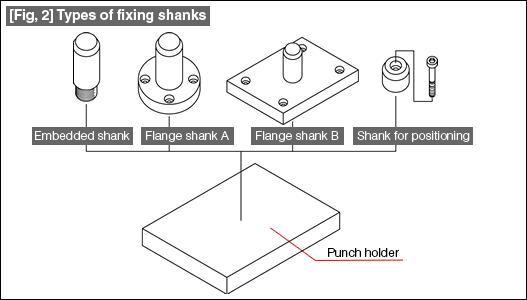#130 Design of Blanking dies (3) Shank Design
The shank is used as a part for installing the top die in the slide of the press machine. This part is not limited to blanking dies, but is used commonly in all types of dies. We describe this first because it is basic information.
The relationship between the shank and the punch holder is shown in Fig. 1. The punch holder is the part being the base, and the shank is installed above it.

A shank is a part with the shape of a pillar, and is used for installing the top die of a relatively small die in the slide of the press machine. The standard diameters of the shank are 25, 32, 38, and 50 mm. These sizes are a legacy from the sizes in inches. Care should be taken because there are some old machines in which the size is not 25 mm but 25.4 mm. The lengths used are about 50 to 65 mm.
The materials used for shanks are SS400, S50C or equivalent, or FC250.
(1)Types of shanks (See Fig. 2)
Embedded shanks and flange shanks are used for fixing the top die. Apart from these, there are shanks for positioning and free shanks (see the descriptions in Lesson No. 171).

(1) Embedded shank
One end of an embedded shank has threads cut on it. The shank is screwed into the hole in the punch holder. After firmly screwing down, sometimes some measure is taken to prevent it from rotating. This is procured at the time of ordering the die set very often.
(2) Flange shank A
This is a shank having a circular flange. Generally, the shank is installed at the center of the die. (In a die with an eccentric load, the position of the shank may be shifted to match with the eccentricity of the load.) In a die having the knock out mechanism (used frequently in blanking dies of the inverted placement structure), an embedded shank may become an obstruction. A flange shank is used in such situations.
(3) Flange shank B
This is a shank having a square flange. While a round flange shank can be machined integrally, this type of shank is very often prepared by combining a standard plate and an embedded shank. This is used when a large area is to be covered by the flange.
(4) Shank for positioning
When the die becomes large, it becomes dangerous to install and retain the top die using a shank (the top die can fall off). In such cases, the top die is fixed using a punch holder. However, when it is necessary to match the centers, a short one is used with respect to the diameter of the shank.
- #167 Problems in Punching and their Countermeasures (6) Scrap Processing in Punching
- #166 Problems in Punching and their Countermeasures (5) Trimming of Drawn and Shaped Parts
- #165 Problems in Punching and their Countermeasures (4) Scrap Clogging in Punching
- #164 Problems in Punching and their Countermeasures (3) Bending and Twisting of Narrow Punched Parts
- #163 Problems in Punching and their Countermeasures (2) Bending due to Punching



